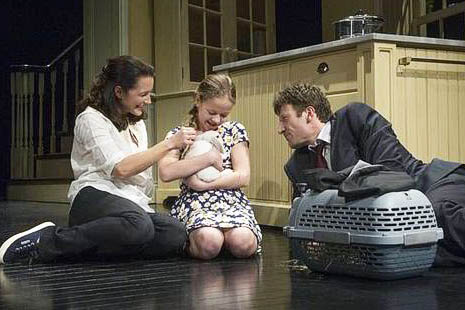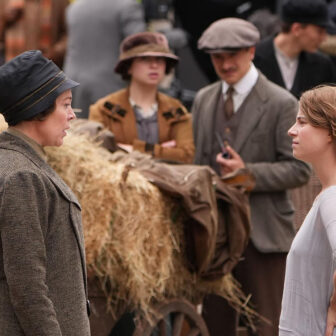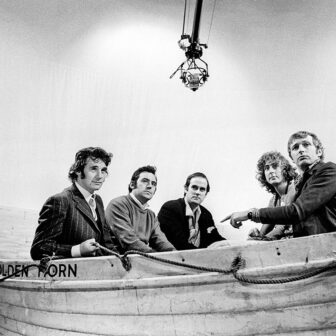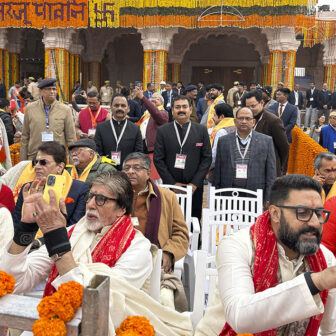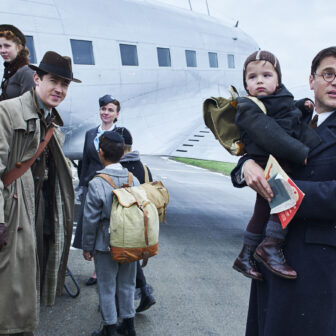WHERE are the modern playwrights of distinction? It’s hard to resist wondering this on running one’s eyes down the list of what’s on offer in London theatre this year. Where are the contemporary equivalents of John Osborne or Harold Pinter? The big popular musicals – The Lion King, The Phantom of the Opera, Les Misérables, to name a few – are still pulling crowds; and there are notable revivals of A Taste of Honey and Ghosts, as well as two Noël Coward resurrections, Blithe Spirit (starring 88-year-old Angela Lansbury no less) and Relative Values. But the most striking phenomenon at the moment is the extraordinary number of plays, musical and otherwise, derived from and/or related to popular films.
Adaptation in one form or other has long been established practice in the arts, perhaps most endemically in the huge reliance of film-makers on works first created in other media, mainly literary but also stage and television; but the sudden efflorescence of titles once famous as films and now to be seen on the marquees of London theatres feels like something new. Just consider this list of what’s on or about to open: Billy Elliott, The Bodyguard, From Here to Eternity, Charlie and the Chocolate Factory, The 39 Steps, Twelve Angry Men, The Full Monty, Made in Dagenham, Dirty Rotten Scoundrels and Fatal Attraction. Certainly some of those also have roots in other art forms, such as novels, but it’s probably no exaggeration to say that the titles are best-known for their film incarnations. Several, like the first four named, have morphed into musicals. The long-running stage version of The 39 Steps owes its origins to the three film versions, most notably of course the 1936 Hitchcock thriller, and they in turn played fast and loose (and for the better) with John Buchan’s novel. And who now can tell how much of the Drury Lane success Charlie and the Chocolate Factory, nearing the end of its first year, derives from Roald Dahl’s much-loved children’s classic and how much from the two film versions, of 1971 and 2005. Well, I guess there’s no proof that a mixed heritage has to be a mixed blessing.
The three discussed here – From Here to Eternity, The Full Monty and Fatal Attraction – were all popular, mainstream films in their time; each had at least one memorable, even shocking, moment; and, judging by the apparent age range at the performances I saw, it seems likely that the audiences have vivid recollections of the films. It seemed fairer not to watch the films again before seeing the stage versions, but the latter can’t help evoking memories of the former. Unlike the situation in which, say, films are derived from novels, we’re talking here about two performed versions of a well-known story.
All sorts of tension: From Here to Eternity
But how will they do the beach scene on stage, I wondered? Like, I suspect, most of the audience at the performance at the Shaftesbury Theatre I recalled one of the most memorable images of the 1953 movie was of Burt Lancaster and Deborah Kerr (Deborah Kerr! So ladylike up till then), swimsuit-clad and locked in each other’s arms as the waves rolled in on their Hawaiian beach.
Tim Rice’s version, and he is producer as well as lyricist, claims allegiance only to James Jones’s 1951 doorstop novel. Jones was prolific for a decade or so, drawing extensively on his wartime experiences, but it is at least arguable that it is Fred Zinnemann’s 1953 film that most people would associate with the title. There is no reference to the film in the very elaborate program which was being sold at the theatre, but there is an essay by Jones’s daughter, Kaylie, reflecting on her father’s attitude to the army, to the men serving in it from a range of backgrounds and motivations, and to war itself. It is a very long time since I read the novel or came across any reference to Jones as an author. James Ivory’s 1998 film version of A Soldier’s Daughter Never Cries can’t be said to have set in train a resurgence of interest in the author who died in 1977. The film version of From Here to Eternity, though, however little Rice was consciously drawing on it, has been shown on television, and it won eight Oscars, including best picture, director, supporting actor and supporting actress, and was nominated for a further five. There was also a TV mini-series starring Natalie Wood in 1979, which I have not seen and which may not have been screened in Australia.
There is a very robust overture from the orchestra, followed by an announcement of the date – 7 December 1941 – and the sound of an explosion, as the curtain rises on the diminutive Private Maggio strumming a guitar and two women standing against a ship’s railing. These two we will later identify as Karen, dissatisfied wife of Captain Dana Holmes of G Company, and Lorene, a prostitute who works for Mrs Kipfer’s establishment, whose clientele is drawn largely from said G Company. One who will make his way there is Private Robert E. Lee Prewitt, boxer and bugler who has given up boxing and bugling, who will fall for Lorene (for some reason I’ve always remembered her telling him that her real name was Alma but Mrs Kipfer had rechristened her Lorene when she “saw it in a perfume ad”). Lorene is pining and planning for respectability and marriage; Karen has had enough of marriage and not enough of sex and, in the interests of getting more of the latter attracts the advances of Sgt Milt Warden, in her husband’s company.
The emotional twists and turns these two couples engage in constitute the main personal narrative, which of course is always being played out against the onset of the cataclysmic events on that critical date. These pairs are more than adequately played by Rebecca Thornhill (Karen) and David Stoller (understudy as Warden at the performance I saw), and Siubhan Harrison (Lorene) and Robert Lonsdale (Prewitt). In fact, Harrison’s Lorene seemed much more credible to me than Oscar-winning Donna Reed’s in the film: I could never accept that nice farm girl from Iowa as a lady of very easy virtue.
Some of the love songs given to these couples, such as “Love Me Forever Today” (Prewitt and Lorene) or Karen’s solo “Maybe,” have an apt enough flavour of poignant longing and uncertainty. They evoke the period quite resonantly while perversely enough also sounding a little old-fashioned. On the whole, it is the big company numbers that come off best. There’s impressive vigour in the choreography of the early “Thirty Year Man” and “Fight the Fight,” and in Act 2’s “Something in Return,” which foregrounds the stars but draws its strength from the ensemble. And the scenes in Mrs Kipfer’s brothel or in the gay bar have a vivacity that’s nearly enough to lift the show, but it is really only in the final minutes of the aerial bombardment that it takes off in the way we keep hoping it will.
The gay bar episode is a reminder of how much freer the stage is now in matters sexual than a 1950s film could be. The play is full of homophobic taunts of “queer” and Maggio “rolls queers” for cash. As well, if the Lancaster-Kerr beach scene seemed sexy in the film, Rice’s version is able to be much more explicit about what’s going on between them and between the G Company men and Mrs Kipfer’s girls. This is no doubt more realistic in terms of the period and place in which it is all set, but it is at least arguable that being more explicit is no guarantee of achieving formidable erotic tension. All sorts of tension are of course finally subsumed in the devastating attack, which is brilliantly staged and lifts the whole production to another level.
Sitting in one place: The Full Monty
Whereas From Here to Eternity has been transformed into a full-scale musical, the theatrical version of The Full Monty seems almost to need musical numbers, but has to wait till the very end to get one – and then it won’t be the main focus of the audience’s attention. As a modestly budgeted film, it did amazing business at the time, and was one of a number of British realist dramas and comedies – and comedy-dramas – that set a lot of youthful careers in motion. One of the chief among these was that of writer Simon Beaufoy, who has now adapted his screenplay into a stage play. In interview, he claimed, “It never occurred to me to turn it into a play till many years later. When I did, I sat down and realised it’s very play-like, in the sense that there’s a lot of people sitting in one place, going nowhere, literally and metaphorically, with nothing else to do except examine their lives.” And that constitutes something of a problem. I don’t remember the film in that kind of detail but “people sitting in one place” and talking can on film be made dynamic through the agency of editing and camera placement. On stage it runs the risk, not altogether avoided here, of seeming static.
The production at the Noël Coward theatre, directed by Daniel Evans, has the initial advantage of a brilliant set by Robert Jones, depicting what appears to be a deserted factory floor, introducing the play’s central concern with unemployment and its personal and social repercussions in the years of Margaret Thatcher’s incumbency. It opens with a comic attempt by two of the unemployed workers – Gaz and Dave – to do something illegal with a steel girder, but there’s a sharper moment that encapsulates the work situation, involving the hiring out of a tie for chaps lucky enough to get called for a job interview. But despite the imaginative effectiveness of the set as a single entity, the play misses the glimpses of homes and pubs and streets – of that outside world and how the economic downturn affects it.
In the event, the spacious set is used essentially, and less imaginatively, for people to gather in to talk throughout the first act. Gaz, estranged from his wife and desperate to maintain connection with his son, hits on the idea of a lucrative male striptease for a women’s night out in a club. The factory floor then becomes the site for interviewing possible participants, the act cunningly building to what was also the film’s punch line, when one of those auditioned, Guy, reveals his major, possibly his only, asset: “The lunchbox has landed,” is Gaz’s shrewd assessment of this potential, and the curtain comes down. The second act involves the rehearsal of the unlikely line-up for the big night as they go about the business of stepping and stripping in time. Rehearsals are interrupted by the visits of several disaffected wives, and by the growth of a gay relationship between the lunchbox and one of the other strippers, with everything leading to the finale, inspired by a recent visit from the Chippendale troupe who’d wooed the ladies successfully but without going “the full monty,” which is what our chaps are proposing.
When this line-up finally takes the stage and tosses garments into the stalls, the lights are tastefully lowered but the spectacle still won a near-hysterical reception from the audience. The theatre audience, made up it seemed largely of middle-aged women, threw themselves into applauding as if they were the club audience, indulging in a happy clap-along. However, for all this enthusiastic response, the play still seemed to miss out on the real pain and underlying seriousness of the film, and given that Beaufoy wrote both, it doesn’t seem too unfair to make such a comparison. There is some real emotional power in Kenny Doughty’s depiction of Gaz, prepared to do anything legal to get the funds he needs to go on seeing his son, but whereas the film seemed like a heartfelt commentary on the way the times were screwing these men the play always seems to be puttering along to the final feel-good moment.
There are some good lines along the way and the audience fell on these, but the northern accents (and most of the cast were allegedly northerners) made some of the dialogue difficult to pick up by uninitiated ears. There is certainly some sense of the camaraderie among the unemployed; there is the odd crisis-of-masculinity moment, such as when Gaz weeps before his wife; there is a pervasive good humour about it all, but… it just misses being important in the way the film was. This may be a result of the changing times or it may be that it misses the intimacy the film used to pinpoint the seriousness. It’s fun, but not much else.
Passion and intelligence: Fatal Attraction
But what about the rabbit? Like the other two theatrical pieces discussed here, Fatal Attraction has its much-remembered moment. (Could it be “iconic”? That word much used to describe anything that more than three people have heard of?) From Here to Eternity has its beach scene; The Full Monty has its rear-view strip show; and Fatal Attraction has its famous rabbit-boiler image. What it also has in common with The Full Monty is that the stage version is again the work of the original screenwriter, James Dearden, and this makes for some revealing comparisons of the two versions.
Whether you’ve seen it or not, it’s safe to say that everyone of a certain age will remember the essential plot of the 1987 film which starred Michael Douglas (later, significantly, a “sex addict”?) and Glenn Close. Dan Gallagher, a thirtysomething lawyer, has a chance meeting with Alex Forrest, a sexy woman of roughly the same age: at a work-related party in the film, in a cunningly lit bar on stage. There is a night of mutually rewarding sexual activity after which he expects to return unscathed to his nice wife and daughter but which Alex takes more seriously. She stalks him through physical presence and via incessant phone calls. The family life, the half of the cake he has wanted to keep having eaten the other half, is irretrievably disrupted.
The plot has been updated to the present and the insidious intrusiveness of mobile phones gives another element of tension and terror to Alex’s relentless stalking. But I’m aware that in referring to “Alex’s stalking,” I’m eliding the play’s subtler distribution of sympathies as compared with the film’s. The latter settled for a ruthless endorsement of the cosy middle-class family unit and the death of Alex at the hands of both Dan and his picture-perfect wife Beth.
There is much more sense in the play of Dan’s weakness in his readiness to slip into glib utterance (“It was fate”; “It was an accident waiting to happen”) and of the innate and blinkered tediousness of Beth’s idealised aspirations (the house in the country, etc.). Above all, there is a much more powerful awareness of Alex’s lonely neediness. The feminist outrage that the original apparently provoked has a good deal less to feed on in the stage version. This is made abundantly clear in the play’s ending: the last image is of Alex, standing in a half-circle of orange light and dripping blood as she dies by her own hand.
It is she we now pity – and not at the expense of overlooking her feral tenacity – and Dan, likable but indubitably weak, has to make do with a far-from-certain future with Beth and their daughter. A very appreciative audience shouted approving boos (sorry if that sounds like an oxymoron) at Dan’s curtain-call appearance at the Theatre Royal, Haymarket. For all I know, this had been carefully orchestrated, but it resonated with Dearden’s wish to reallocate sympathies in ways commerce-dominated Hollywood had refused to allow twenty-five years earlier.
I need to get a couple of niggles out of the way. First, the noise level: both the non-specific explosion-type bursts of sound and the thematically apt excerpts from Madame Butterfly were needlessly damaging to the eardrums. It was as if they were meant to match sonically the visual intensity of the staging. As to the latter, this is often brilliant as one setting slides with almost cinematic fluency among bars, parks, offices and homes, but even then there is an unrewarding stridency about the long strips of violently purple lighting that divide the stage. On another level, Dan’s recurring address to the audience as he reflects increasingly wildly on his dilemma seems unnecessary. Most of the play is told in what would be called “flashback” if this were a film, with Dan talking to his affable divorced friend Jim about his grim situation. This being so, we don’t need Dan’s explicit comments to us: we’ve seen it happen and we’ve heard Dan talking to Jim.
These reservations aside, Fatal Attraction emerges as a powerful study of relationships, whether those complacently accepted or those remorselessly driven by the need for gratification, sexual or other. It is dextrously staged and performed with real passion and intelligence by Natascha McElhone (Alex), Mark Bazeley (Dan) and Kristin Davis (Beth), not to forget the brilliant little girl (Holly Barrett was the one I saw) who plays Dan’s daughter, Ellen, witness to scenes of marital ferocity that should be no part of a child’s experience.
The physical violence that breaks out on several occasions is as alarming as it should be (I was even afraid the combatants might fall over the edge of the stage). There was, too, inspired use of extras – for example as bar habitués or joggers – to evoke the world in which the central trio were so vividly performing their danse macabre.
Films derived from plays can sometimes seem stagy talk-fests or they can “open out” in what appear obvious ways. The reverse adaptation process may sometimes suffer from an over-strenuous attempt to emulate film’s obvious mobility in time and place. But each form is capable of achieving its own rewards. I don’t think any of the three works highlighted here is a model of film-to-theatre transition, but nothing is going to stop producers from trying. At the time of writing, the latest to be announced is Shakespeare in Love, due to open in July. For all I know, someone is already planning to bring Pirates of the Caribbean to Drury Lane.
